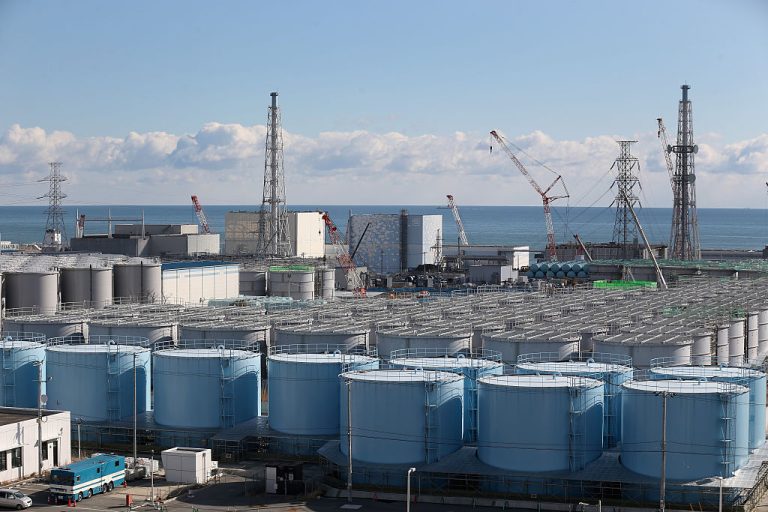In a frenzy fueled by Beijing’s propaganda, mainland Chinese have been in a panic over supposed health and environmental impacts of Japan’s discharge of treated nuclear wastewater into the Pacific Ocean.
Despite containing far less radioactivity
Chinese went into a frenzied buying spree, snatching up salt, erroneously believing its use could thwart the negative effects of radiation exposure.
Another item that quickly sold out was radiation detectors like Geiger counters.
Once in hand, people began testing everything from snacks they purchased from the grocery store to the interior of their homes and many discovered a disturbing truth; radiation levels in and around their homes in China far exceed radiation levels around the Fukushima site.
Success
You are now signed up for our newsletter
Success
Check your email to complete sign up
A woman from Shanghai posted on a social media platform that after measuring her home with a Geiger counter, she found it was 976 times more radioactive than Tokyo. According to her post, the radiation level at her home is worse than Fukushima which measures at 3.0, whereas her home measured a disturbing 9.7.
She pointed out that according to official state-run Chinese media, Tokyo’s value was just 0.01, meaning her home registered radiation levels 976 times that of Tokyo.
Another netizen found that his bedroom registered radiation at 0.3, his kitchen at 0.8 and his bathroom 1.9, all exceeding that of Tokyo.
When he compared radiation levels between foodstuffs imported from Japan and domestic products, he found that the domestic products threw off more radiation than Japanese imports prompting him to stop testing out of fear of what else he may find.
Panic in Zhuhai
At the beginning of September, a state media report detailing airborne radiation levels in major Chinese cities went viral on the country’s social media platforms.
It indicated that the city of Zhuhai had the second-highest radiation levels in the country, behind Tibet, which is exposed to natural levels of radiation due to its active geological conditions and higher altitude which increases exposure to cosmic radiation.
Many blamed or suspected Japan was the source of the radiation.
“The government should test the seawater in the direction of Japan,” one user remarked while another said, “The rise could be the result of Typhoon Saola, which has blown seawater from Japan to the coast of China.”
According to the South China Morning Post, China acquires its data “through 368 automatic radiation monitoring stations across China, 118 of them located around nuclear power plants in a fan-shaped pattern. The rest are in urban parks, rooftops, and green spaces in major cities.”
Mainlanders compared the radiation levels in a number of Chinese cities to radiation levels in Tokyo.
They found that while Tokyo registered at 0.19 and Fukushima at 0.20, while a number of Chinese provinces were much, much higher.
They found that radiation levels found in Shandong measured upwards of 94, Zhejiang and Fujian Provinces measured radiation levels at 93 and Guangdong province at 112.
READ MORE:
- Amid Fukushima’s Wastewater Controversy, China-Japan Relations Reach a Boiling Point
- British Official Announces ‘Nuclear Power Renaissance’
- China Fuming Over Japan’s Fukushima Nuclear Waste Water Plan, May Completely Ban Seafood Imports From Japan
Radiation all around us
According to the International Atomic Energy Agency (IAEA), “Naturally occurring radioactive materials are present in [the Earth’s] crust, the floors and walls of our homes, schools, or offices and in the food we eat and drink. There are radioactive gases in the air we breathe. Our own bodies – muscles, bones, and tissue – contain naturally occurring radioactive elements.”
However, this does not account for the radiation levels being observed in many Chinese communities.
Readings from a station at Sun Yat-sen University in Zhuhai revealed levels consistently above 130, however the Zhuhai Ecological Environment Bureau (Zhee) said the numbers were within normal range.
“Historical data in Zhuhai indicates a range of 127.9 to 332.1, so 130 is considered normal,” the university claimed and blamed the high levels of radiation on naturally occurring factors.
According to the IAEA “there is still considerable uncertainty about the overall effects” of low doses of radiation.
“It is presumed that exposure to radiation, even at the levels of natural background, may involve some additional risk of cancer,” the agency says.
However the agency is adamant that “No human activity or practice is totally devoid of associated risks. Radiation should be viewed from the perspective that the benefit from it to mankind is less harmful than from many other agents,” such as cancer risks from tobacco smoke, ultraviolet light, asbestos, some chemical dyes, fungal toxins in food, and even heat.














